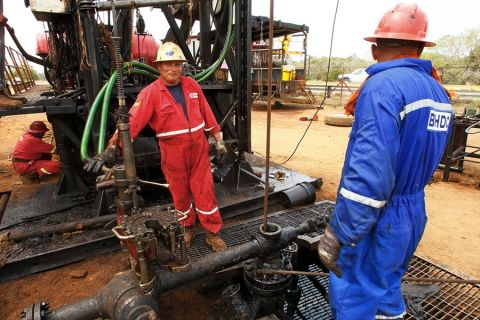
Oil and gas companies that look to the future by embracing talent development, data-driven optimization and continuous product capability monitoring will be miles ahead of the rest. (Source: Shutterstock.com)
Legacy energy companies are enacting sweeping business changes to keep up with evolving energy demands. Several major factors are affecting those changing demands.
First, growing public attention toward climate change is pressuring companies to adopt cleaner, more efficient practices. Second, the plummeting cost of alternative energy sources and increasing government regulation of carbon emissions are pushing companies to embrace new energy solutions. Third, competition in the industry has increased greatly, with an influx of startups developing alternative and innovative solutions.
It’s an entirely different landscape from even a decade ago.
All of this change means that modern leaders of once-stable legacy companies must embrace flexibility within their business models. It’s a harsh reality: The same service lines that sustained the company in the past are no longer relevant. Many leaders are struggling with the idea that once-lucrative offerings may become unprofitable.
In addition to external pressures for alternative and updated products, a major cultural change is occurring within the industry. Top workers are reconsidering how to approach their career paths. Historically, employees at traditional energy companies could expect to spend their entire careers working up the ladder at one company, but that model is becoming less realistic as people wonder how the shift away from hydrocarbon will reshape the industry. Now, top talent is demanding skill and leadership development as well as assurance that the executive team has a vision for how the company fits into the energy transition. People want to learn new skills and meet the changing landscape head-on.
Clearly, legacy energy companies will need to innovate or die. Royal Dutch Shell Plc is a great example of how to dive into transformation. The company has been transparent with its strategies to both hold itself publicly accountable and accelerate transformation from a petrochemical company into a more generalized energy player. Shell’s investors understand what it’s trying to do and are affording the company the appropriate runway to do it. Meanwhile, Exxon Mobil Corp. has gone to exceptional lengths to preserve its dividend in order to attract investors who believe in a slower transition.
The good news is that some of the very things responsible for changing the landscape of the industry will be the solutions for moving forward. Developed talent, optimized value chains and product capability approaches will help energy companies run headfirst into the next normal. Here’s how each of these ideas can lead to innovation.
1. Prioritize upskilling and talent development.
Lately, I’ve heard people wonder whether oil and gas will become like the tobacco industry—still around, but a place where many people don’t see viable futures or simply wouldn’t want to work. New energy companies are enticing smart, creative talent away from traditional energy companies. They say, “Wouldn’t you rather go where the market is growing rather than shrinking?” People (especially those early in their careers) recognize the potential upside in connecting to emerging solutions rather than remaining hitched to dying models.
Many established energy companies have prioritized stabilizing careers for the long term, which can make it difficult to bring in new and different skills to the talent pool. If your company has a fixed hiring strategy, consider hybridizing your talent base where it makes sense. For example, emphasize opportunities in job rotation and cross-training on new operations.
Reallocate talent to newer, more relevant initiatives so they can become familiar with emerging solutions and upskill along the way. Organizations that take a forward-facing stance in their operations and planning are likely to show strong market resilience and to effectively identify and pair existing core strengths with tomorrow’s opportunities.
2. Use data insights to optimize your value chain.
Data capabilities will be key components of measuring progress toward innovation and will provide insights about how the business is (or is not) transforming. On this front, traditional energy companies actually have a huge advantage: Being an established player means you likely have a wealth of data that new entrants do not.
The actual pace of the energy transition is unknown. But companies should carefully monitor the market for the drivers behind the energy transition. Leveraging information (public and proprietary alike) will better your chances of pinpointing actionable insights others may not have. The right discovery at the right time could mean the difference between crucial strategic positioning and market irrelevance. The goal is to glean from that data movements and opportunity zones in which those newer to energy do not have visibility.
3. Continuously and objectively monitor product capability.
At the most basic levels of transformation, we can expect those surviving energy companies will have to sunset existing products while adopting cleaner alternatives. This will surely take trial and experimentation, and many new products will fail. Yet it will be vital to maintain a mindset of objective analysis and willingness to try new solutions (while accepting failure along the way).
Companies must be able to reevaluate how their products are perceived and utilized in the marketplace. Legacy energy companies that rested on the laurels of momentum will need to develop and practice using customer engagement muscles. And even beyond customer engagement, companies must be able to monitor the landscape as a whole for opportunities and emerging market trends.
The long-term ROI will be in developing new products and capabilities related to new energy opportunities. That means companies will need to invest heavily in R&D—and be comfortable with that idea of trying, failing, learning and trying again.
This broad transition away from legacy energy will be a historical challenge for many established companies. Energy companies will have to innovate, or they will surely be left in the dust. The only path forward means accepting the risk and reward of innovation. The companies that look to the future by embracing talent development, data-driven optimization and continuous product capability monitoring will be miles ahead of the rest.
Editor’s note: Opinions expressed by the author are their own.
Pariveda’s Derrick Bowen has more than 11 years of consulting experience leading user-centered software development, CRM, business intelligence, and strategy projects in industries including energy (traditional and renewable), healthcare and financial services.
Recommended Reading
US Decision on Venezuelan License to Dictate Production Flow
2024-04-05 - The outlook for Venezuela’s oil industry appears uncertain, Rystad Energy said April 4 in a research report, as a license issued by the U.S. Office of Assets Control (OFAC) is set to expire on April 18.
Hirs: LNG Plan is a Global Fail
2024-03-13 - Only by expanding U.S. LNG output can we provide the certainty that customers require to build new gas power plants, says Ed Hirs.
Renewed US Sanctions to Complicate Venezuelan Oil Sales, Not Stop Them
2024-04-19 - Venezuela’s oil exports to world markets will not stop, despite reimposed sanctions by Washington, and will likely continue to flow with the help of Iran—as well as China and Russia.
CERAWeek: Energy Secretary Defends LNG Pause Amid Industry Outcry
2024-03-18 - U.S. Energy Secretary Jennifer Granholm said she expects the review of LNG exports to be in the “rearview mirror” by next year.
From Satellites to Regulators, Everyone is Snooping on Oil, Gas
2024-04-10 - From methane taxes to an environmental group’s satellite trained on oil and gas emissions, producers face intense scrutiny, even if the watchers aren’t necessarily interested in solving the problem.





